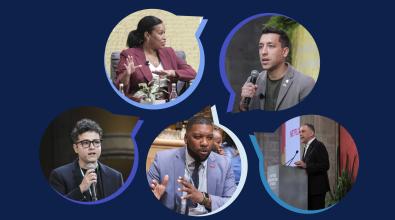How a city video went viral—and what you can learn from it

Few things are more crucial to cities and the people they serve than the annual operating budget. And few things are more difficult to present to residents in a way that will engage them and get them to focus on the real-life priorities behind the rows of numbers.
But even the annual budget rollout can be made relatable—even fun—if you approach it with an open mind, the desire to innovate and the willingness to take a chance.
Cities such as San Jose, Calif., and Phoenix have employed engaging, interactive budget tools. And Arlington, Texas, Director of Communication and Legislative Affairs Jay Warren and his communications team found the key to unlocking the potential of a budget announcement in the most unlikely of places: the world of Legos.
Build, Unite, Create: Using Lego Bricks to Explain Arlington’s FY2022 Budget, the stop-motion video Warren and his colleagues created earlier this year, has received nearly 600,000 views since it was posted on Aug. 3. Considering that Arlington’s population is about 400,000, that’s a pretty amazing reach.
“It’s rare that when we launch our budget videos that I get emails from people, saying, ‘Wow, that’s cool,’” Warren says. “We went out on a limb.” And it worked.
Here are some lessons the team learned.
Be sure the message meets the moment
The initial spark for the idea in Arlington came from Warren, a self-described “big Lego nerd” from childhood on, who has an entire Lego city set up at his home. The team had hoped to do the Lego-style treatment earlier, but the pandemic intervened and made the theme of building a budget seem a bit off-key. This year, Warren said the idea seemed to resonate. “For a couple of reasons it worked,” he says. “We are building a budget again this year, either with the resources that the federal government provided or what we’re seeing with people going back to shopping and getting back to normal. And at the same time, if felt like people needed to smile and needed a little joy.”
The main concern was to have some fun with the video, but also treat the $552 million general budget with the seriousness it deserves. “How do you do something that’s fun but also smart and informative?” Warren says the team asked themselves. “That was a guiding principle—you can be fun but also smart and really help educate people in an adult way.”
In Phoenix, city officials launched the Fund PHX budget tool in 2019 to give residents a more easily accessible and transparent way to look at the city’s $1.6 billion general operating budget. The tool allows users to easily navigate through budget categories and suggest spending more or less on key priorities—but only if the overall budget remains in balance. San Jose has used a similar tool to solicit suggestions on how to close a $25 million deficit in the city’s $1.3 billion general operating budget.
Don’t be afraid to take a risk
In most city halls, the process of rolling out the annual budget is not exactly a sandbox for potential innovation. But Warren says that when he and his team raised the idea, the reaction was uniformly positive; go for it. “We had some head scratching from people,” he says. “But they took a leap of faith on us. We’ve been doing budget videos for a while, so there was a built-in reservoir of, ‘Well, I think they know what they’re doing.’”
The fact that the project didn’t need additional budget and could be done in the same two-week time frame—shooting a LEGO city requires less driving around a 99-square-mile city than a normal video shoot—helped seal the deal, Warren says.
In Phoenix, changing the way the budgets had traditionally been rolled out enabled more inclusive feedback. Assistant City Manager Jeff Barton, who led the creation of Fund PHX when he was the city’s budget research director, says Phoenix had previously relied on 15 to 20 public hearings a year to solicit input on the budget. “But we knew that some people just weren’t comfortable coming to those meetings,” he says. “We wanted to find a unique way to allow people to give those comments on the budget but also tell us what their priorities are while giving people a sense of how the budget works.”
“We had 1,500 comments on the budget last year,” says city budget research director Amber Williamson, including the tool and other channels of communication. “That’s the most I can remember ever receiving from the public.”
Trust your team to take on new challenges
Surprisingly, given the technical complexities of shooting stop-motion video, the Lego project was filmed completely in-house, by Warren’s team. That process included solving a number of challenges that he’d never even considered, such as figuring out how to get the mouths of the Lego characters to move and finding a way to show diversity with Lego figures that all have the same skin tone.
“It took a little research on how to do stop-motion but they found a very cool program that helped a lot,” Warren says. He adds that while he’s the only Lego aficionado on his team, his colleagues warmed to the chance to do something different and creative. “I think they really got into it,” he says. “It was a different way to tell the story and it was a way for them to expand their skill set and do something that was out of the box.”
Creativity isn’t anything new to this team. In fact, Arlington’s creative approach to communications earned them recognition as the inaugural winner of the Sharman Stein Award for Storytelling Changemakers from Results for America in 2019. This year's award went to Port St. Lucie, Fla.
All these examples—whether in Phoenix, Arlington, San Jose, or other cities—offer lessons on how to give even the most routine tasks of city government new life and relevancy. As Arlington’s Warren explains, there are also side benefits as well.
“When we screened the video for the council this year for the first time, people clapped,” he says. “We’d never gotten applause before.”


